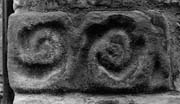Select a site alphabetically from the choices shown in the box below. Alternatively, browse sculptural examples using the Forward/Back buttons.
Chapters for this volume, along with copies of original in-text images, are available here.
Object type: Part of cross-shaft
Measurements: H. 79 cm (31 in); W. 41.5 > 38.2 cm (16.3 > 15 in); D. 28 cm (11 in)
Stone type: Coarse-grained (with quartzite pebbles up to 8 mm), feldspathic, very pale brown (10YR 7/4) grit; Millstone Grit, Namurian, Upper Carboniferous; probably reused Roman ashlar, originally from Hetchell Crag (Thorner) or Otley areas (see Fig. 5)
Plate numbers in printed volume: 214-315
Corpus volume reference: Vol 3 p. 83
(There may be more views or larger images available for this item. Click on the thumbnail image to view.)
Only two faces are visible.
?A (broad): The edge moulding survives. Two very large and deeply cut scrolls from a continuous plant-scroll survive. There are no leaves but the node is swollen and the spiral terminates in a roundel with an incised circle within it.
?D (narrow): The other exposed face (a dressed internal section) is plain.
This is very large-scale work for a shaft. It is possible that it is part of an architectural frieze in the manner of Breedon, Leicestershire (Cramp 1977, 196–7, fig. 50). The absence of an edge moulding would support this. It is clumsily cut. The plant-scroll has few foliate flourishes but some attempts at a berry terminal, so it is probably late Anglian. It is quite a large-scale piece, with deep cutting.



